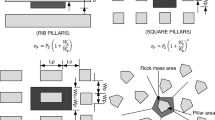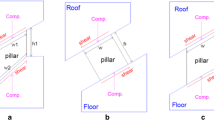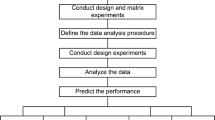Abstract
Room and pillar sizes are key factors for safe mining and ore recovery in open-stope mining. To investigate the influence of room and pillar configurations on stope stability in highly fractured and weakened areas, an orthogonal design with two factors, three levels and nine runs was proposed, followed by three-dimensional numerical simulation using ANSYS and FLAC3D. Results show that surface settlement after excavation is concentrically ringed, and increases with the decrease of pillar width and distances to stope gobs. In the meantime, the ore-control fault at the ore-rock boundary and the fractured argillaceous dolomite with intercalated slate at the hanging wall deteriorate the roof settlement. Additionally, stope stability is challenged due to pillar rheological yield and stress concentration, and both are induced by redistribution of stress and plastic zones after mining. Following an objective function and a constraint function, room and pillar configuration with widths of 14 m and 16 m, respectively, is presented as the optimization for improving the ore recovery rate while maintaining a safe working environment.
Similar content being viewed by others
References
HUSTRULID W A, BULLOCK R L. Underground mining methods: Engineering fundamentals and international case studies [M]. Englewood, USA: Society for Mining, Metallurgy, and Exploration, 2001: 493–495.
MA Hai-tao, WANG Jin-an, WANG Yun-hai. Study on mechanics and domino effect of large-scale goaf cave-in [J]. Safety Science, 2012, 50(4): 689–694.
LI Jiang-teng, CAO Ping. Catastrophe analysis on pillar instability considered mining effect [J]. Journal of Central South University of Technology, 2005, 12(1): 102–106.
BOGERT H, JUNG S J, LIM H W. Room and pillar stope design in highly fractured area [J]. International Journal of Rock Mechanics and Mining Sciences, 1997, 34(3/4): 145–158.
DENG J, YUE Z Q, THAM L G, ZHU H H. Pillar design by combining finite element methods, neural networks and reliability: A case study of the Fenghuangshan copper mine, China [J]. International Journal of Rock Mechanics and Mining Sciences, 2003, 40(4): 585–599.
BRADY T, CLARK R P L. Design in weak rock masses: Nevada underground mining operations [C]// Proceedings of SME annual meeting. Salt lake, USA: SME, 2005: 43–51.
SUORINENI F T, TANNANT D D, KAISER P K. Determination of fault-related sloughage in open stopes [J]. International Journal of Rock Mechanics and Mining Sciences, 1999, 36(7): 891–906.
DAI Hua-yang, LI Wen-chang, LIU Yi-xin, JIANG Yao-dong. Numerical simulation of surface movement laws under different unconsolidated layers thickness [J]. Transactions of Nonferrous Metals Society of China, 2011, 21(s3): 599–603.
MAHDI S, CHARLIE C L. A numerical study of stress changes in barrier pillars and a border area in a longwall coal mine [J]. International Journal of Coal Geology, 2013, 106: 39–47.
GEORGIOU S D. Orthogonal design for computer experiments [J]. Journal of Statistical Planning and Inference, 2011, 141(4): 1519–1525.
HE Jiang, DOU Lin-ming, CAO An-ye, GONG Si-yuan, LÜ Jian-wei. Rock burst induced by roof breakage and its prevention [J]. Journal of Central South University, 2012, 19(4): 1086–1091.
POULSEN B A, SHEN B. Subsidence risk assessment of decommissioned bord-and-pillar collieries [J]. International Journal of Rock Mechanics and Mining Sciences, 2013, 60: 312–320.
ZHU Wei-bing, XU Jia-lin, KONG Xiang, XUAN Da-yang, QIN Wei. Study on pillar stability of Wongawilli mining area in shallow close distance coal seams [J]. Procedia Earth and Planetary Science, 2009, 1(1): 235–242.
ZHAO Xing-dong, LI Lian-chong, TANG Chun-an, ZHANG Hong-xun. Stability of boundary pillars in transition from open pit to underground mining [J]. Journal of Central South University, 2012, 19(11): 3256–3265.
MEDHURST T P, BROWN E T. A study of the mechanical behaviour of coal for pillar design [J]. International Journal of Rock Mechanics and Mining Sciences, 1998, 35(8): 1087–1105.
Author information
Authors and Affiliations
Corresponding author
Additional information
Foundation item: Projects(50934002, 51074013, 51104100) supported by the National Natural Science Foundation of China; Project(IRT0950) supported by the Program for Changjiang Scholars and Innovative Research Team in University of China
Rights and permissions
About this article
Cite this article
Wu, Ax., Huang, Mq., Han, B. et al. Orthogonal design and numerical simulation of room and pillar configurations in fractured stopes. J. Cent. South Univ. 21, 3338–3344 (2014). https://doi.org/10.1007/s11771-014-2307-7
Received:
Accepted:
Published:
Issue Date:
DOI: https://doi.org/10.1007/s11771-014-2307-7




